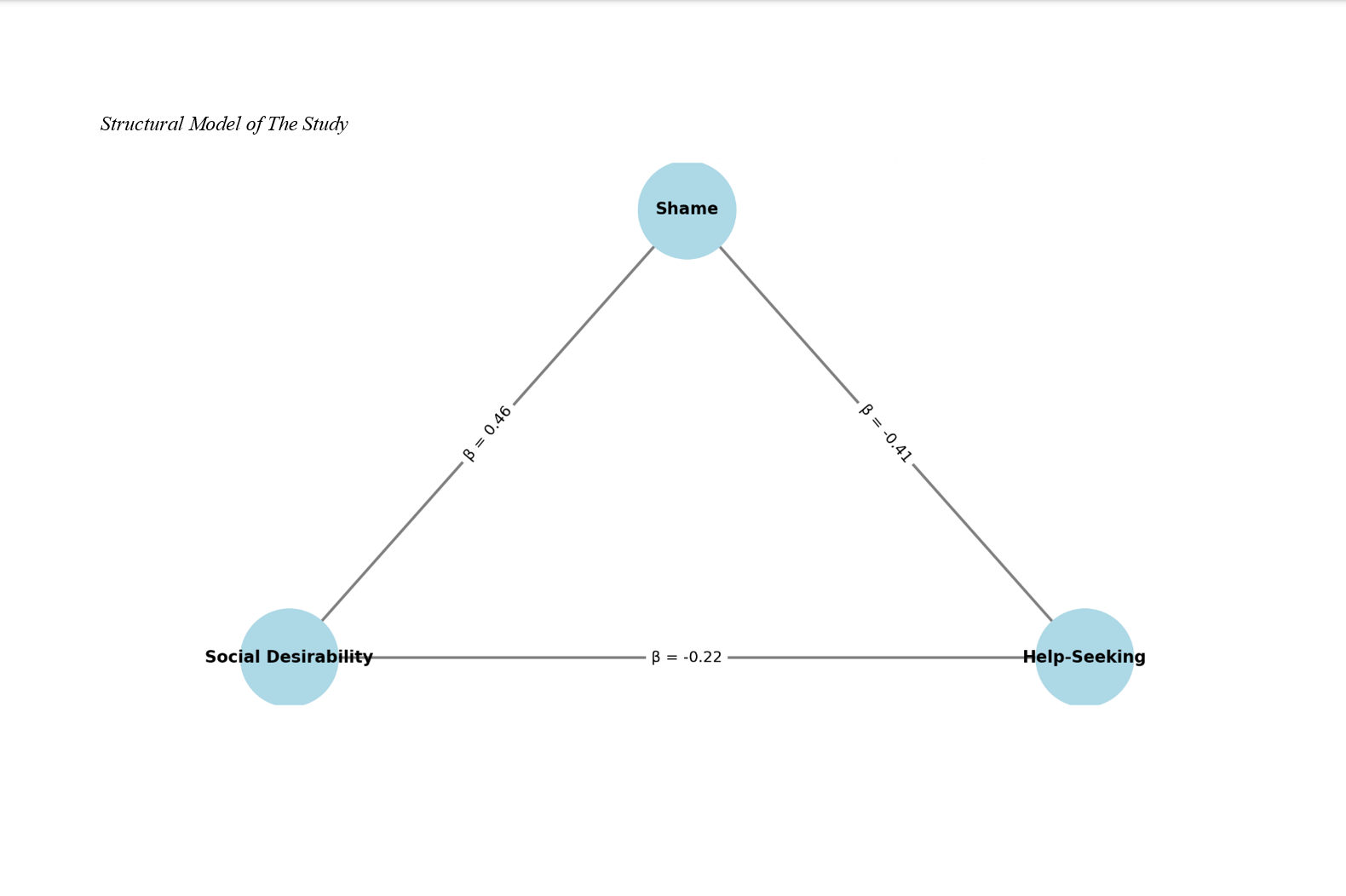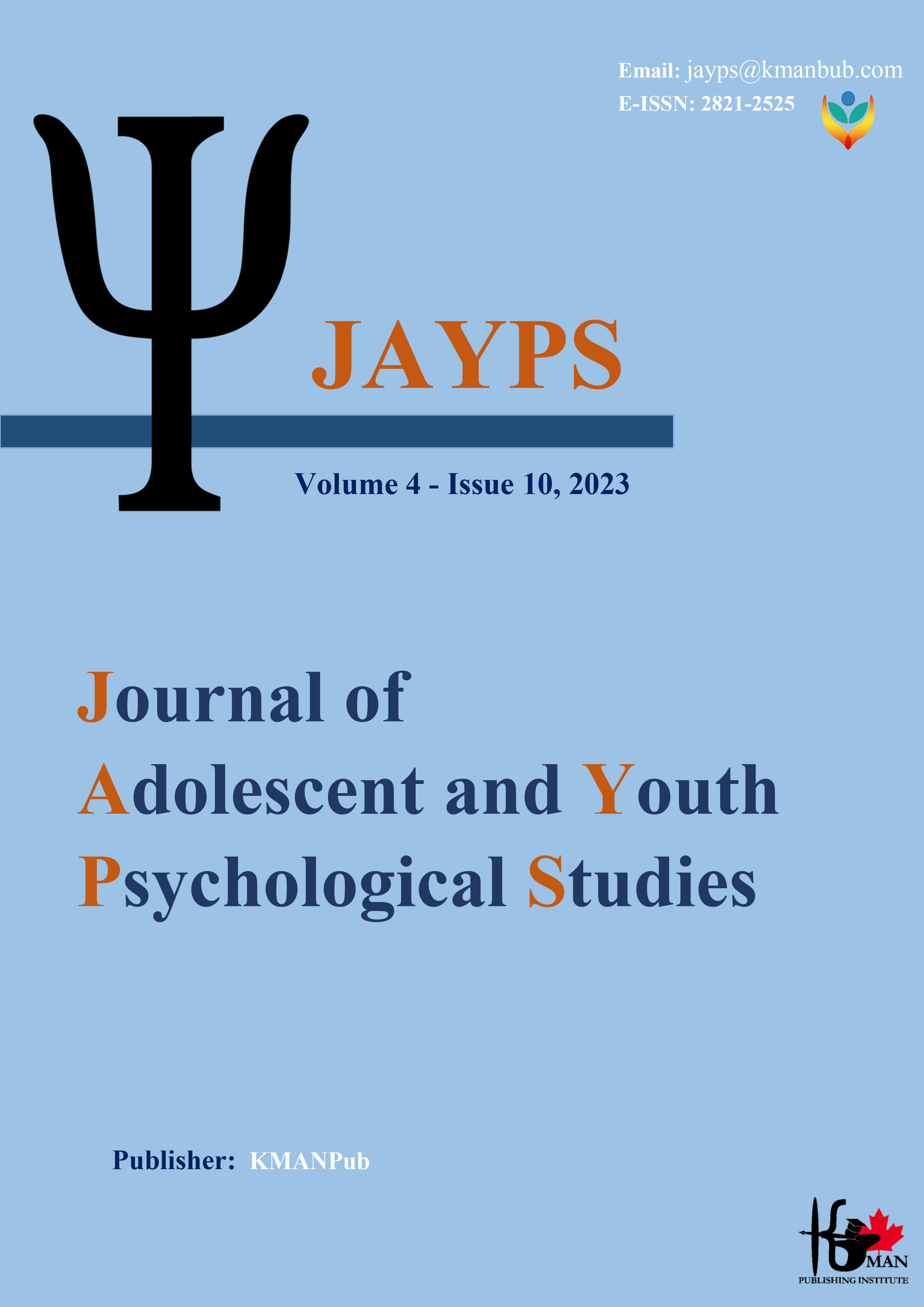Social Desirability and Its Effect on Help-Seeking: Mediated by Shame
Keywords:
Help-seeking behavior, Social desirability, Shame, Mediation, Mental health stigma, Malaysia, Structural Equation ModelingAbstract
Objective: The present study aimed to investigate the relationship between social desirability and help-seeking behavior, with shame as a mediating variable, among a sample of Malaysian participants.
Methods and Materials: This research employed a descriptive correlational design and was conducted on a sample of 391 participants from Malaysia, selected based on the Morgan and Krejcie sample size table. Standardized instruments were used to assess help-seeking (General Help-Seeking Questionnaire), social desirability (Marlowe-Crowne Social Desirability Scale), and shame (Experience of Shame Scale). Data were analyzed using SPSS-27 for descriptive statistics and Pearson correlation analysis, and AMOS-21 was employed to conduct Structural Equation Modeling (SEM) to test the hypothesized mediation model and assess the model fit using key indices such as CFI, RMSEA, and TLI.
Findings: Descriptive analysis revealed moderate levels of help-seeking (M = 4.62, SD = 1.13), high social desirability (M = 21.87, SD = 4.76), and elevated shame (M = 68.34, SD = 9.51). Pearson correlation analysis showed that social desirability was negatively correlated with help-seeking (r = −.41, p < .001) and positively with shame (r = .46, p < .001), while shame was negatively correlated with help-seeking (r = −.52, p < .001). SEM results indicated that the structural model had good fit (CFI = 0.97, RMSEA = 0.048, TLI = 0.96), with shame significantly mediating the relationship between social desirability and help-seeking. Both direct and indirect effects of social desirability on help-seeking were statistically significant.
Conclusion: The findings highlight that shame plays a critical mediating role in the negative relationship between social desirability and help-seeking behavior. Interventions aimed at reducing internalized shame and addressing socially desirable responding may be essential for improving help-seeking behaviors, especially in cultural contexts where stigma and social expectations are prominent.
Downloads
References
Aytaç, A., & Durat, G. (2019). The Investigation of the Relationship Between Childhood Trauma and Feelings of Guilt- Shame and Self-Esteem in Karabuk University Students. Sağlık Akademisi Kastamonu, 4(3), 144-187. https://doi.org/10.25279/sak.499339
Budiarto, Y., & Helmi, A. F. (2021). Shame and Self-Esteem: A Meta-Analysis. Europe’s Journal of Psychology, 17(2), 131-145. https://doi.org/10.5964/ejop.2115
Cameron, C., Kotera, Y., & Fido, D. (2022). The Relationship Between Sex Addiction and Shame Moderated by Overt and Covert Narcissism in a Gender-Balanced Adult Sample. https://doi.org/10.31234/osf.io/9m4fs
Çavuş, F., Çıvgın, U., & Yorulmaz, E. (2023). The Mediating Role of Self-Esteem in the Relationship Between Impulsivity, Shame and Gambling Severity. 5(3), 228-238. https://doi.org/10.35365/ctjpp.23.3.05
Chen, X., Dai, B., Li, S., & Liu, L. (2024). Childhood Maltreatment, Shame, and Self-Esteem: An Exploratory Analysis of Influencing Factors on Criminal Behavior in Juvenile Female Offenders. BMC psychology, 12(1). https://doi.org/10.1186/s40359-024-01758-x
Cox, S. J. (2021). Gender Differences in Reporting Anger and Social Desirability Bias The University of Texas at San Antonio]. https://search.proquest.com/openview/1140f0a8a1b5730fe3213b841222ee1c/1?pq-origsite=gscholar&cbl=18750&diss=y
Doyle, J. N., Cormier, L. A., & Hymers, M. J. (2022). Shame-Proneness Mediates Relations Between Borderline Personality Disorder Symptom Severity and Domains of Sexuality in Undergraduate Women. The Canadian Journal of Human Sexuality, 31(2), 207-216. https://doi.org/10.3138/cjhs.2022-0002
Elfitasari, T., & Winta, M. V. I. (2022). The Role of Self-Esteem in Mediating Social Anxiety on Body Shaming Victims. Psikostudia Jurnal Psikologi, 11(2), 249. https://doi.org/10.30872/psikostudia.v11i2.7405
F.W, S., Dekker, J., Peen, J., & Geert Jan, J. M. S. (2016). Narcissism, Self-Esteem, Shame Regulation and Juvenile Delinquency. Forensic Science and Criminology, 1(1). https://doi.org/10.15761/fsc.1000105
Fallah, N. (2023). Socially Prescribed Perfectionism and Burnout Among Foreign Language Learners: The Role of Shame and Self-Esteem. Language Teaching Research Quarterly, 32, 36-52. https://doi.org/10.32038/ltrq.2022.32.03
Fiskum, C., & Eik‐Nes, T. T. (2023). Erfaringer Med Samtalekortene «Hei Kropp Og Selvfølelse»: En Kvalitativ Undersøkelse. Tidsskrift for Norsk Psykologforening, 60(7), 414-422. https://doi.org/10.52734/nchg3914
Gök, F. A., Yazgan, E. Ö., Yildiz, T. A., & Duyan, V. (2020). Sosyal Hizmet Bölümü Öğrencilerinin Psikolojik Yardım Aramada Kendini Damgalama Durumunun Ve Benlik Saygısının Belirlenmesi. Opus Uluslararası Toplum Araştırmaları Dergisi, 1-1. https://doi.org/10.26466/opus.661207
Johnson, A. J. (2020). Examining Associations Between Racism, Internalized Shame, and Self-Esteem Among African Americans. Cogent Psychology, 7(1). https://doi.org/10.1080/23311908.2020.1757857
Kardiatun, T. (2021). Body Shaming Dengan Harga Diri Dan Mekanisme Koping Remaja. Jurnal Keperawatan Dan Kesehatan, 12(1), 13-23. https://doi.org/10.54630/jk2.v12i1.143
Kim, o. j., & Choi, b. y. (2023). The Moderating Effect of Self-Esteem on the Relationship Between Avoidant Attachment and Professional Help-Seeking Attitude in Undergraduate Students. Korean Association for Learner-Centered Curriculum and Instruction, 23(7), 901-915. https://doi.org/10.22251/jlcci.2023.23.7.901
Kim, P. Y., Kendall, D. L., & Chang, E. (2016). Emotional Self-Control, Interpersonal Shame, and Racism as Predictors of Help-Seeking Attitudes Among Asian Americans: An Application of the Intrapersonal–interpersonal-Sociocultural Framework. Asian American Journal of Psychology, 7(1), 15-24. https://doi.org/10.1037/aap0000032
Kim, Y. H. (2019). The Effects of Anxious Attachment on Social Anxiety in College Students: Mediation Effects of Self-Esteem, Shame and Narcissistic Vulnerability. Korean Journal of Stress Research, 27(2), 174-182. https://doi.org/10.17547/kjsr.2019.27.2.174
Kotera, Y., Tsuda‐McCaie, F., Edwards, A. M., Bhandari, D., Williams, D., & Neary, S. (2022). Mental Health Shame, Caregiver Identity, and Self-Compassion in UK Education Students. Healthcare, 10(3), 584. https://doi.org/10.3390/healthcare10030584
Lagerström, M., Johnsson, P., Orrenius, B., Järvholm, K., Olbers, T., & Engström, M. (2025). Internalized Shame in Treatment-Seeking Adults With Obesity Class II-III and Its Association With Quality of Life, Body Image, and Self-Esteem. Obesity Facts, 1-12. https://doi.org/10.1159/000543448
Liyanovitasari, L., & Setyoningrum, U. (2022). Gambaran Harga Diri Remaja Yang Mengalami Body Shaming. Pro Health Jurnal Ilmiah Kesehatan, 4(2). https://doi.org/10.35473/proheallth.v4i2.1758
Lotfi Saedabad, S., Basharpoor, S., & Rafiee rad, Z. (2022). The mediating role of social desirability in the relationship between personality traits and dysfunctional attitudes with adolescent aggressive behaviors [Research]. Rooyesh-e-Ravanshenasi Journal(RRJ), 11(4), 75-88. http://frooyesh.ir/article-1-3349-en.html
Mahadevan, N., Gregg, A. P., & Sedikides, C. (2023). How Does Social Status Relate to Self-Esteem and Emotion? An Integrative Test of Hierometer Theory and Social Rank Theory. Journal of Experimental Psychology General, 152(3), 632-656. https://doi.org/10.1037/xge0001286
Melizza, N., Rahmawati, A., Arfianto, M. A., Mashfufa, E. W., Kurnia, A. D., & Masruroh, N. L. (2023). The Relationship Between Body Shaming and Self-Esteem in Students. Kne Medicine. https://doi.org/10.18502/kme.v3i2.13084
Ningrum, J. S., & Mulawarman, M. (2024). The Influence of Gratitude and Self-Esteem on Psychological Help-Seeking Behavior in Vocational School Students. Counsenesia Indonesian Journal of Guidance and Counseling, 5(2), 105-115. https://doi.org/10.36728/cijgc.v5i2.3696
Nur Arissa Aini Mohamad, A., & Mohd.Nor, H. A. (2023). Experiences of Sexual Harassment and Its Association With the Levels of Depression and Self-Esteem Among Female Higher Education Students in Selangor. International Journal of Academic Research in Business and Social Sciences, 13(12). https://doi.org/10.6007/ijarbss/v13-i12/19782
Omari, O. A., Sawafi, A. A., Al‐Adawi, S., Aldiabat, K., Dameery, K. A., Albashtawy, M., Alkhawaldeh, A., Musa, A., Sabei, S. A., Qadire, M. A., & Aljezawi, M. e. (2024). Assessing Attitudes Toward Seeking Psychological Professional Help Among Adolescents: The Roles of Demographics and Self-Esteem. BMC psychology, 12(1). https://doi.org/10.1186/s40359-024-02294-4
Razmus, M., Czubak‐Paluch, K., & Brytek‐Matera, A. (2022). The Relationship Between Body Mass Index and Food Preoccupation in Women: A Moderated Mediation of Body‐related Self‐conscious Emotions and Self‐esteem. European Eating Disorders Review, 31(1), 188-196. https://doi.org/10.1002/erv.2955
Shehzad, G., & Ahsan, S. (2023). Moderating Role of Self-Esteem Between Traumatic Events and Internalized Shame Among Retired Army Officers. HNJSS, 4(2), 544-559. https://doi.org/10.71016/hnjss/k1s9rt32
Thomson, P., & Jaque, S. V. (2018). Shame and Anxiety: The Mediating Role of Childhood Adversity in Dancers. Journal of Dance Medicine & Science, 22(2), 100-108. https://doi.org/10.12678/1089-313x.22.2.100
Wood, L., Byrne, R., Burke, E., Enache, G., & Morrison, A. P. (2017). The Impact of Stigma on Emotional Distress and Recovery From Psychosis: The Mediatory Role of Internalised Shame and Self-Esteem. Psychiatry research, 255, 94-100. https://doi.org/10.1016/j.psychres.2017.05.016

Downloads
Additional Files
Published
Submitted
Revised
Accepted
Issue
Section
License

This work is licensed under a Creative Commons Attribution-NonCommercial 4.0 International License.








